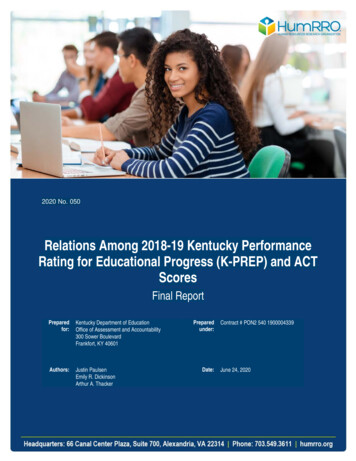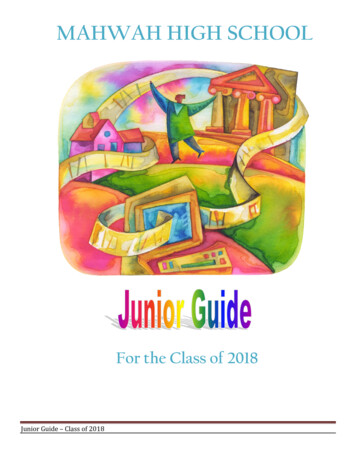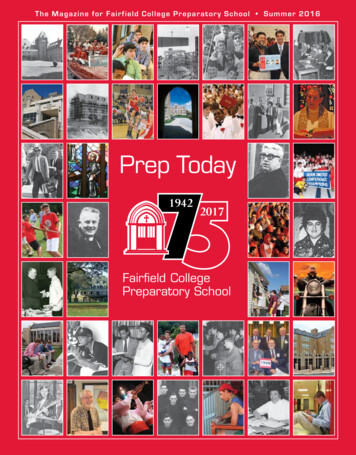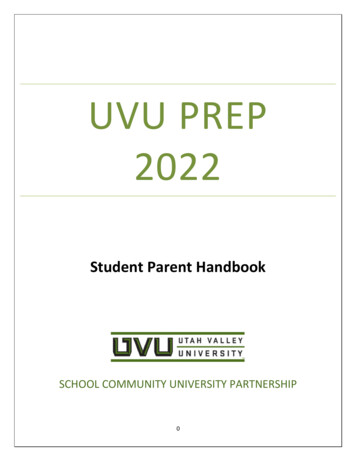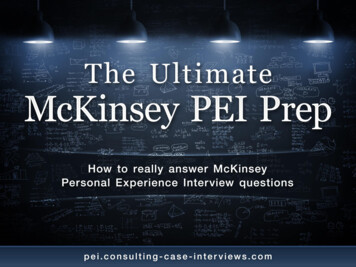
Transcription
All rights reserved. No part of this publication may be reproduced, distributed, or transmitted in any formor by any means, including photocopying, recording, or other electronic or mechanical methods, withoutthe prior written permission of the publisher, except in the case of brief quotations embodied in criticalreviews and certain other noncommercial uses permitted by copyright law. For permission requests, writeto the publisher at office@consulting-case-interviews.com.
Table of Contents (1/5)1. The Big Picture BONUS6PEI is the most underestimated part of the recruiting process but matters more than you might thinkMcKinsey requires not only „hard“ analytical skills but also „soft“ interpersonal skills, putting a lot of weight on the PEIFrom a high-level perspective, you just need to be client-ready and company-compatible to pass the PEILooking at the PEI in a simplified way, being successful boils down to mastering only few key aspectsThe PEI is part of at least 3 interview sessions and is approx. 10-12 min. in duration, length can vary substantiallyEach interview session contains only one PEI, and each PEI contains only one dimension to focus onDuration is not correlated to importance of interview components, especially considering the PEIRecruiting process for experienced hires looks differently and is specific to the potential hire, but still including the PEIA side note to the warm-up/ice-breaking phase and candidates’ own questions in the interview71214151720212224BONUS 1: Common CV-/background-related questions of McKinsey interviewersBONUS 2: Sample questions to ask for candidates at the end of the interview session26312. McKinsey Candidate Assessment Dimensions OverviewThe single components of the interview process focus on different aspects of a candidateEach dimension has same importance for the overall assessment, „Problem Solving“ is not part of the PEI dimensions“Entrepreneurial Drive” vs. “Drive and Achievement” dimension naming36373842
Table of Contents (2/5)3. The PEI DimensionsWhat McKinsey is looking for in potential hires has a clear connect to the McKinsey way of workingEach dimension has various necessary core elements to consider when developing your examples – OverviewEach dimension has various necessary core elements to consider when developing your examples – LeadershipEach dimension has various necessary core elements to consider when developing your examples – Personal ImpactEach dimension has various necessary core elements to consider when developing your examples – Entrepreneurial DriveEven though the dimensions seem to be easy to distinguish in the first place, lots of candidates mix them upYour examples can come from different contexts4. The PEI Preparation ProcessTo ideally prepare for the PEI, the following six-step-process should be followed1 – Gaining a clear understanding of each dimension2 – Identifying suitable situations3 – Structuring each suitable situation – 27 pages on structuring your example for a bullet-proof storyline4 – Develop each PEI example in detail5 – Practice and receive feedback6 – Rework and refine your stories43444546495357596566676974101103104
Table of Contents (3/5)5. The Secret McKinsey PEI Cheat SheetEach PEI dimension has many specifics to consider when building your examples – don’t get lost in the detailsLeadershipPersonal impactEntrepreneurial drive6. PEI Sample QuestionsEven though there are a lot of different ways a question can be asked, the underlying issues remain the sameLeadershipPersonal ImpactEntrepreneurial Drive7. PEI Sample Stories From Successful CandidatesThe specific context matters less than you think – what is much more important is your specific role and actionLeadership: „Customer satisfaction in professional service firms“Leadership: „Re-aligning the local consulting club“Leadership: „White paper initiative at a US tech company“Leadership: „Organizational change in a small company“Leadership: „Aligning the start-up founders 33135137
Table of Contents (4/5)Personal Impact: „Organizational politics during internship“Personal Impact: „Dealing with a challenging customer“Personal Impact: „Doctoral thesis in the US“Personal Impact: „Difficult colleagues at university faculty“Personal Impact: „Dealing with a hospital patient“ (1/2)Achievement: „Organizing a conference without budget“Achievement: „Developing a top-selling iPhone app“Achievement: „Founding an Asian cuisine restaurant“Achievement: „Leading the university business club to new health“Achievement: „Establishing an online politics platform“8. PEI Tactical Issues to ConsiderTake your time before you actually start off with your PEI exampleMake sure to really answer the question asked by your interviewerFollow your interviewer’s guidance to talk about those issues he is really interested inAs an absolute minimum, you should prepare two stories for each dimensionPrepare to show your self-reflection to the 157158162
Table of Contents (5/5)9. PEI Common Mistakes to AvoidUsing “stories” instead of “examples” or “situations” in your PEI wordingNot being specific enough in your exampleChoosing an example from some years ago alreadyReferring more to „we“ instead of „I“Not putting enough structure into your exampleShowing a lack of self-reflectionTalking too much about the situation instead of your abilitiesNot preparing enough to talk about „soft“ factorsHaving practiced your examples too much and sounding recitedFaking examples which never happened this way10. Bonus 3: Must-Read Books on Consulting Or if you want to check out Robert’s FREE contentmeanwhile, please go to Quora.com - ’s McKinsey PEI Blog - s.com164165166167168169170171172173174176
What real other candidates say about Robert’sMcKinsey PEI Prep"Robert is a very professional and friendly coach. The insight he provided me tobetter prepare the PEI are invaluable and I felt very comfortable exchanging withhim. Furthermore he took additional time in the session to ensure I got the better ofit. I would strongly recommend him.""A very friendly and professional expert partner. The session was very helpful,informative and interesting. Moreover, I also enjoyed the fact that Robert is veryflexible and patient. He reacted to my specific questions and provided me with tailoredand bespoke advice. I would definitely advice to apply for sessions with Robert.""Great experience, very considerate and helpful feedback, tailored to my specificsituation and weaknesses.Very effective communication and pleasure to work together!"
What real other candidates say about Robert’sMcKinsey PEI Prep"Robert provided incredibly useful input, has mademe feel much more confident about the PEI sectionof the interview!""Robert is an excellent coach if you want tocrack your PEI interview with McK.I highly recommend him." and hundred’s more real reviews onwww.preplounge.com
About RobertHi, my name is Robert and I wanted to say hello and welcome you to your McKinsey PEI prep - it's great to seeyou preparing for the McKinsey PEI at all (you wouldn't believe how many candidates are going to McKinseyinterviews without a solid PEI prep - needless to say, a surefire way to unnecessarily lose your McKinsey offer!).As we didn't have had a chance yet to get to know each other in one ofmy high-impact interview coachings, I just felt it's good to give you a briefidea about my background as well.I am the founder of consulting-case-interviews.com, multiple bookauthor on consulting interview prep, a high-impact case interview & PEIcoach since 2010 having secured McKinsey offers for candidates evenwithout having them go through final round interviews [yes, they onlyneeded to sign the contract with a partner, without any more interviewsby them], most viewed writer on 'case interviews' on Quora.com withmore than 100.000 views on my answers, PrepLounge Premium Expertwith 95% recommendation rate and some more things like that.I don't intend to brag with all that, nor to bore you to death - just want toemphasize that this is serious stuff which works 100%!
Geographical spread ofThe Ultimate McKinsey PEI Prep eBook
1The Big Picture(SAMPLE CHAPTER,followed by ghost deck)
The Big PicturePEI is the most underestimated part of the recruiting process butmatters more than you might think (1/5)The Personal Experience Interview (PEI) is the most underestimated part of the whole McKinseyinterview process, due to the following reasons: You have no idea about McKinsey’s specific evaluation criteria and where to focus on in yourexamples. On the internet, there is hardly any detailed and actionable information available onthis very part of your interview sessions. On the McKinsey website you just get a general ideaabout the topics to be discussed – but that’s virtually all, no hint on where to focus on andwhich criteria McKinsey uses in the background to evaluate your performance:
The Big PicturePEI is the most underestimated part of the recruiting process butmatters more than you might think (2/5) You are expected to be prepared, anyway. As a future top-management consultant, you areexpected to prepare yourself to the best extent possible with all information which is availablebeforehand. Being lazy in your preparation efforts and not doing your homework upfront isdefinitely no excuse for bad interview performance – and no interviewer will feel sorry for youif you don’t perform on this part of the interview process and get kicked out. The bar for passing the PEI is much higher than you would ever expect. Even though not muchinformation is shared, McKinsey interviewers have extremely high standards concerning thePEI. Why? Because when looking at candidates, interviewers don’t look at them as everlastingdata-crunching machines, but as potential future engagement managers (project managers).Therefore, the “soft” skills are even more relevant than “hard” problem solving skills, and thusa very important aspect when taking on new hires, no matter for which entry level.
The Big PicturePEI is the most underestimated part of the recruiting process butmatters more than you might think (3/5) You think that preparing some general CV-related questions and looking over pastexperiences and achievements is enough to prepare. This approach is maybe a kind of start forthe PEI prep, but if that is all you are planning to prepare, then it’s better to save your time andenergy and don’t even go any further in your interview process (and it does not matter at all ifyou are the top performer in the case study and/or Problem Solving Test!). You severely underestimate how detailed the PEI will get and get caught by surprise once youare sitting in your real interview. Experience from my hundreds of PEI coaching sessions since2009 shows that basically all candidates are astonished by how detailed the McKinsey PEI reallygets. Most candidates finish preparing their stories on a level where it just starts to getinteresting for the interviewer. And yes, it is true that interviewers sometimes ask about theprecise words you were using in a specific situation. Since technically speaking the McKinsey PEIis a behavioral interview, the interviewer really wants to understand not only the situation ingeneral, but especially your actions and decision-making rationale in great detail – that’s whatwill be evaluated, as opposed to the general situation and context as such.
The Big PicturePEI is the most underestimated part of the recruiting process butmatters more than you might think (4/5)However, sometimes you might be lucky – but it’s kind of stupid to rely on luck when it comes toa possible jump-start of your whole life-long career after long years of heavy investment intoyour education:Let me share a personal story with you on this one. I recently had a coaching client located inWestern Europe who asked me to focus in our preparation solely on the case study as she feltconfident about the PEI and hence did not want to spend valuable coaching time on this part.She scored extremely high in the analytical case study part and there was not a single issue theinterviewers could give her as a feedback for further improvement for the upcoming 2nd roundinterviews (which were scheduled on a different day than first round interviews, fortunately). At thesame time, however, she was told that her performance on the PEI was definitely less than idealand much worse than she would have been expected on the basis of her background and vastexperience shown in her CV.
The Big PicturePEI is the most underestimated part of the recruiting process butmatters more than you might think (5/5)Fortunately enough, her PEI performance was at least borderline and thus temporarily acceptablefor the interviewers, as they let her pass on to the 2nd round interviews. However, she had a clearwarning sign attached that the only way to finally receive an offer was to really impress theinterviewers on the PEI in the 2nd and final round of her interviews.The only reason why this candidate got a 2nd chance (and after heavy coaching on the PEI also anoffer in Switzerland office, finally) was solely because she was one of the best candidates ever inZurich office in terms of her analytical mindset and problem solving skills.Since I give you honest and balanced information on this topic: Yes, it is also possible to get tosecond (final) round interviews without perfect PEI performance in the first round as well.Would I want to rely on this kind of luck for my career? Definitely not, and neither should you.To receive one of the very rare McKinsey offers, it is key to mastering the PEIby understanding the specifics of the McKinsey PEI clearly andpreparing seriously for this part of the recruiting process.
The Big PictureMcKinsey requires not only „hard“ analytical skills but also „soft“interpersonal skills, putting a lot of weight on the PEI (1/2) Alongside doing a lot of data analytics especially in the more junior ranks of the consultingfirms, there is still a high level of very intense relations with the client organization starting withday one as a consultant. After all, consulting is a people business, thus McKinsey is putting a lotof weight on recruiting the “right” candidates with appropriate soft skills as well. Due to the importance and impact of McKinsey projects, there is an inherently high potentialfor conflicts within client organizations. More often than not, the context for working below theC-level execs hierarchy is not that desirable and less than ideal – and as a future McKinseyconsultant you are mainly left alone with all this as part of your everyday job:––––––Personal interests, hidden agendas and office politics of various people in the organizationCrisis situation with a need of immediate high-impact actionGeneral reluctance of client employees sharing information with the consultantClient employees‘ fear about your power in the organization and potential secret project goalsHigh uncertainty of client employees about potentially negative changes for them personally – usuallyMcKinsey is not hired and paid millions to leave everything as it is within the client organizationTime pressure to achieve tangible results to move forward in the project
The Big PictureMcKinsey requires not only „hard“ analytical skills but also „soft“interpersonal skills, putting a lot of weight on the PEI (2/2) While “hard”, analytical problem-solving skills (which are mainly tested in the case studyinterview part) are still a crucial evaluation criterion in the McKinsey recruiting process, thoseskills can be trained and acquired comparatively easy. On the contrary, “soft” interpersonal skills cannot be that easily trained and acquired from oneday to the next, but require practical experience in addition to the conceptual/theoretical basis- therefore McKinsey is looking even more closely for those soft skills than for hard analyticalskills in the interview process. However, for the PEI it is clearly not enough to having some experience in those “soft”interpersonal skills under your belt. For a successful PEI and consequently getting your desiredMcKinsey offer, you also need to communicate your skills in a very structured and precise wayto get your points across within the very limited time for the PEI.Due to massive challenges faced by interacting with the client organization, a lot of weight is puton the “soft“ skills side in the recruiting process. Getting your McKinsey offer is impossible with alow score on the PEI since having those “soft” skills is crucial to McKinsey.
The Big PictureFrom a high-level perspective, you just need to be client-readyand company-compatible to pass the PEIActually, what does client-ready mean?Apart from being confident about a candidate‘s analytical skills, the McKinsey partner bearing theoverall responsibility for the client relationship and project outcome needs to be a 100% sure thathe can send you on a business trip around the world to the client on your own, knowing that youwill definitely deliver the desired results even within a hostile client organization, and do not screwup and put the client relationship at risk already in your first week of the project.And what the heck is company-compatible?Looking on this matter from a company-internal perspective, the often-cited „airport test“ comesin: being stranded at a remote airport, could your interviewer imagine spending a good time withyou nevertheless? Well, you also might end up spending a lot of days and most likely nights workingtogether on tough problems.When in doubt, the recruiter always goes for the candidate with excellent soft skills and goodanalytical skills, and not for the candidate with excellent analytical skills and good soft skills.
The Big PictureLooking at the PEI in a simplified way, being successful boils downto mastering only few key aspects (1/2) Above all, the interviewer needs to have a good (gut) feeling after your PEI that whatever thespecific situation is that you will be in at some point in time, you will be successful and doingfine (leading a team, convincing someone, achieving difficult goals).––––For this, your interviewer needs to understand in great detail your actions in a real example from yourpast, and even more importantly your decision-making rationale in this situationJust by looking at your actions, it is not possible to fully backwards-engineer your thoughts (“decisionmaking rationale”)But exactly that’s the key aspect to assess for the interviewer since only by understanding your (mental)approach towards a specific situation, your interviewer will be able to get a solid impression about yourskills in any of the 3 PEI dimensionsThis will be finally leading to a positive (gut) feeling that you will be able to resolve any difficultsituation in your future career as top management consultant as well, no matter about the specificsituation at hand because you have the “right” approach in thinking about and resolving thosesituations
The Big PictureLooking at the PEI in a simplified way, being successful boils downto mastering only few key aspects (2/2) However, you also need to communicate your examples and skills in the correct way duringthe PEI – just having them under your belt is by far not enough.–––Thinking about the McKinsey recruiting process, it should be obvious that all candidates invited to onsite interviews will have the required background and thus examples and skills – otherwise they wouldnot even have received an invitation to on-site interviews.Hence, just having those examples and skills will not differentiate you in any way from other candidates– it is the way how you prepare your PEI in terms of structure and focus of your examples.Unfortunately no candidate gets this right in the beginning, posing a huge threat to your overallinterview success and finally also leading to extremely high failure rates of otherwise very strongcandidates, just because of the PEI – and it’s a pity that it is just about the communication of previousexperiences, not about fundamentals like having good examples in the first place (which is likestumbling on the last few meters before the finish line of a marathon run).After your PEI, the interviewer needs to be positive that you will be handling difficult situations infuture well too – just having the right experiences under you belt is the minimum requirementand prerequisite to get invited to on-site interviews, but won’t be enough to pass the PEI.
The Big PictureThe PEI is part of at least 3 interview sessions and is approx. 10-12min. in duration, even though length can vary substantially (1/3)Typical McKinsey recruiting process overview 1st round usually consists of 3-4 sessions – 3 case study interviews with PEI if applicablethe Problem Solving Test (PST - depending on candidate’s background) Each interview session has principally the same sequence, including the PEI part The sequence for the PST varies in the first round interviews (if applicable at all)1-5 min.Case study1stroundPersonal ExperienceInterview20-35 min.Interviewsession 1Interviewsession 2Interviewsession 32ndroundWarm-up /ice breaking10-12 min.Interviewsession 4Interviewsession 5Interviewsession 61-5 min.Candidates’questionsProblem SolvingTest (PST)
The Big PictureThe PEI is part of at least 3 interview sessions and is approx. 10-12min. in duration, even though length can vary substantially (2/3) 2nd round usually consists of 1-3 or more interview sessions with more senior staff(usually partner/director level) - depending on the first round interviews, an accordingnumber of interviews will be scheduled for the 2nd round Even though the interview process is standardized (for non-experienced hires), theexact number of interviews in the second round depends on your first roundperformance Some of my coaching candidates received their offer directly after the three firstround interviews due to their stellar performance, having had only an administrativechat about the contract and details with a partner in the second round interviews Other candidates however needed to go through three additional 2nd roundinterviews with partners and directors, until they could finally convince McKinseythat they are an excellent hire for the company
The Big PictureThe PEI is part of at least 3 interview sessions and is approx. 10-12min. in duration, even though length can vary substantially (3/3) In any case, everything can happen in the 2nd round interviews since partners anddirectors have no need to follow standardized recruiting procedures, but are doingexactly those things in their interviews that they think brings the most value for acandidate’s assessment (and they do have a good gut feeling for that) At the same time, 2nd round interviewers are receiving an in-depth briefing aboutyour 1st round interview performance, and will therefore focus on exactly thoseissues which were not 100% perfect in the 1st round interviews to really make surethat you possess the respective required skills As preparation for 2nd round interviews it therefore makes sense to focus on exactlythose issues which did not go perfectly well and were borderline in the 1st roundinterviews – if you got some feedback from interviewers or got to understandyourself that your PEI was not perfect in 1st round interviews, you need to havebetter examples at hand for the 2nd round to get your desired McKinsey offerIn any case you should have additional PEI stories prepared for 2nd round interviews – you may ormay not need all of them, but if your PEI performance was only borderline and not close toperfect in the 1st round, you should expect a heavy focus on PEI in your 2nd round interviews.
The Big PictureEach interview session contains only one PEI, and each PEIcontains only one dimension to focus on At least for first-round interviews, you can expect your interview sessions to be standardizedand thus each interview session will contain 1 PEI (and doing the math based on the number ofinterview sessions you will have on a given day, you know the absolute minimum number ofexamples you need to have prepared)Also in your second-round interviews, you can be expect to have 1 PEI per interview session forplanning purposes – however, this will strongly depend on your PEI performance of yourprevious interview sessions and might lead to an even stronger focus on PEI (by having moreextended PEIs time-wise, or having multiple PEIs within 1 interview session)Each PEI will focus solely on one specific dimension–– In any given interview session, you will talk about either leadership or personal impact orentrepreneurial driveYour examples for the PEI are not expected to combine all three PEI assessment dimensions in onesingle example – actually not only that it is not expected, it would be even a surefire way to blow yourMcKinsey interviews trying to bring in multiple PEI assessment dimensions into one single example,since given the limited time you will most definitely not have enough time to go into the details andspecifics of the situation that the interviewer would be interested inWhereas in some McKinsey offices you don’t receive any information upfront concerning thesequence of your PEI dimensions, in other offices you receive a detailed schedule upfrontwhich interviewer will ask you about which PEI dimension
The Big PictureDuration is not correlated to importance of interview components,especially considering the PEIWhen looking at the duration of each interview component in the McKinsey recruiting process,do not fall into the common trap to think that the PEI is not that important because it is relativelyshort compared to the other components like PST and case interview.DurationImportancePST CasePEIUsually, PEI duration is only 10-12 minutes of any given interview sessionHowever, length can very substantially based on the candidate’s background – especiallycandidates with lacking evidence of soft skills in their educational curriculum or extra-curricularactivities tend to have more extensive PEI’s up to 25 minutes (followed by a shorter case-study)Even though short in time, the PEI’s importance for the overall interview performance evaluationis equal to the case study and even much more important than the Problem Solving Test – stilllot’s of candidates don’t prepare accordingly and consequently fail in their interviews.
The Big PictureRecruiting process for experienced hires looks differently and isspecific to the potential hire, but still including the PEI For partner-level hires, McKinsey has usually 3 rounds of interviews–––– While some interviews are face-to-face, quite some other interviews will be via video conference sinceinterviewers will be very specifically chosen for the potential hire and are thus often only availableremotely due to travel logisticsRound 1 is usually consisting of 4 interview sessions, focusing on motivation and specific areas ofexpertise of the candidateRound 2 is usually consisting of another 4 interview sessions, focusing more on case interviews PEI aswellRound 3 is usually designed based on interview round 1 and 2, but will still contain a few moreinterview sessions – it’s not uncommon to have even more than 15 interviewsEven though the recruiting process for experienced hires is designed individually on a case-bycase basis, the PEI is still a vital component for the overall assessment and is following the samebasic principles as for any other candidate
High-Impact – 1:1 – 100% RISK-FREE*Have a 100% risk-free coaching*Save tons of time preparing your PEIChoose the right examples for your PEIGain an edge over other candidatesSignificantly reduce the risk of failureGet a reality check of your own examplesFor More Information & Booking Please s.com/* If your stories are close to perfect already and I cannot find any significant improvement for your McKinsey PEI, guess what – I will make a full refunddirectly at the end of your coaching session! Therefore it's 100% risk-free for you - you will end up paying for the coaching session only if I can add value foryour McKinsey PEI prep.
The Big Picture – BONUSA side note to the warm-up/ice-breaking phase and candidates’ ownquestions in the interview – even though not part of the PEISince I get regularly asked in my one-on-one PEI coaching sessions the following two questions, Iwill also answer them in this resource, even though they are not part of the PEI as such:1. Which general CV-/background-related questions McKinsey interviewers are asking at the verybeginning of the interview, before the PEI even begins?2. Which questions are candidates supposed to ask the interviewers at the end of the interviewsession?For sure the answers to those two questions are less critical for your evaluation than the PEI andcase study. However, at the same time they are still contributing to a go/no-go decision regardingyour potential McKinsey offer – therefore diligent preparation should be a matter of course as well.
1The Big Picture – BONUS 1
The Big Picture – BONUS 1Common CV-/background-related questions of McKinseyinterviewers (1/4)
The Big Picture – BONUS 1Common CV-/background-related questions of McKinseyinterviewers (2/4)
The Big Picture – BONUS 1Common CV-/background-related questions of McKinseyinterviewers (3/4)
The Big Picture – BONUS 1Common CV-/background-related questions of McKinseyinterviewers (4/4)
1The Big Picture – BONUS 2
The Big Picture – BONUS 2Sample questions to ask for candidates at the end of the interviewsession (1/5)
The Big Picture – BONUS 2Sample questions to ask for
author on consulting interview prep, a high-impact case interview & PEI coach since 2010 having secured McKinsey offers for candidates even without having them go through final round interviews [yes, they only needed to sign the contract with a partner, without any more interviews by them], most viewed writer on 'case interviews' on Quora.com with


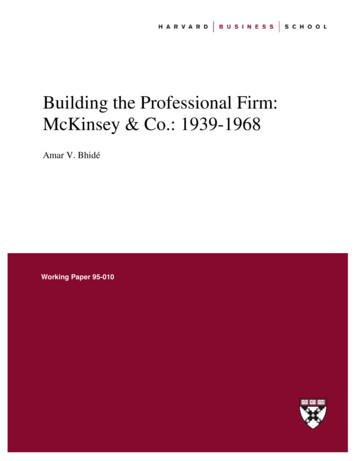
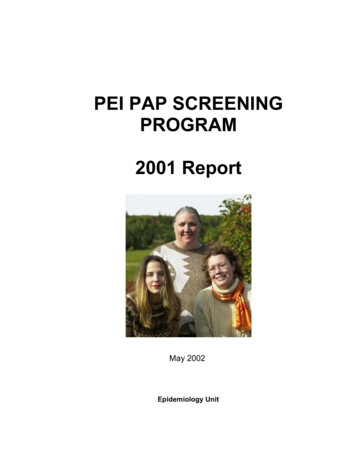
![[McKinsey Style Case] Ace Your Consulting Case Interviews](/img/64/wso-meat-processing-webinar-april-17-0-0.jpg)


